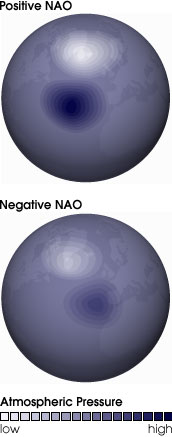North Atlantic oscillation facts for kids
The North Atlantic Oscillation (often called NAO) is a natural weather pattern in the Atlantic Ocean. It describes how the air pressure changes between two important areas: the Icelandic Low and the Azores High. Think of it like a giant seesaw for air pressure!
When the NAO changes, it affects the strength and direction of winds that blow across the North Atlantic. It also changes where big storms travel. The NAO is a part of a larger pattern called the Arctic oscillation. It changes all the time, but not in a regular, predictable way.
Scientists first learned about the NAO in the late 1800s and early 1900s. Unlike the El Niño–Southern Oscillation in the Pacific Ocean, the NAO mainly involves changes in the atmosphere (the air around us). It's one of the most important ways the climate changes in the North Atlantic and nearby wet regions.
Contents
What is the North Atlantic Oscillation?
The North Atlantic Oscillation is a big weather pattern. It shows how the air pressure changes over the North Atlantic Ocean. Air pressure is simply the weight of the air pushing down on the Earth.
How Air Pressure Affects Weather
When air pressure is high, the weather is usually calm and sunny. When it's low, you often get stormy and windy weather. The NAO looks at the difference in air pressure between two key places:
- The Icelandic Low: This is a spot near Iceland where air pressure is usually low.
- The Azores High: This is a spot near the Azores islands where air pressure is usually high.
The NAO describes how the strength of these two pressure systems changes. Sometimes the Icelandic Low is very strong, and sometimes the Azores High is very strong. These changes affect the weather across a huge area.
How the NAO Works
The NAO has two main phases: a positive phase and a negative phase. These phases describe how the air pressure difference changes.
Positive NAO Phase
In the positive phase, the Icelandic Low is stronger than usual. At the same time, the Azores High is also stronger than usual. This means there's a bigger difference in air pressure between the two areas.
- Winds: Stronger westerly winds blow across the Atlantic. These winds bring mild, wet air.
- Storms: Storms tend to travel more to the north.
- Europe: Northern Europe often gets mild, wet winters. Southern Europe might have drier conditions.
- North America: Eastern North America often experiences milder winters.
Negative NAO Phase
In the negative phase, the Icelandic Low is weaker. The Azores High is also weaker. This means the difference in air pressure between them is smaller.
- Winds: Weaker westerly winds blow across the Atlantic.
- Storms: Storms tend to travel more to the south.
- Europe: Northern Europe often has colder, drier winters. Southern Europe might get more rain.
- North America: Eastern North America can experience colder, snowier winters.
Why is the NAO Important?
The North Atlantic Oscillation is very important because it affects the weather for millions of people. It influences:
- Temperature: How warm or cold winters are in Europe and North America.
- Rainfall and Snow: How much rain or snow falls in different regions.
- Storm Tracks: Where big storms travel, which can impact shipping and travel.
- Ocean Currents: It can even affect ocean currents, which play a role in climate.
Understanding the NAO helps scientists and weather forecasters predict long-term weather patterns. This can help people prepare for different seasons, especially for farming, energy use, and managing water.
NAO and Other Climate Patterns
The NAO is connected to other large-scale climate patterns.
Arctic Oscillation (AO)
The North Atlantic Oscillation is closely linked to the Arctic oscillation (AO). The AO is a pattern of air pressure changes over the entire Arctic region. The NAO can be seen as a part of this larger Arctic Oscillation, specifically focusing on the Atlantic part.
Atlantic Multidecadal Oscillation (AMO)
It's important not to confuse the NAO with the Atlantic Multidecadal Oscillation (AMO). The AMO is about changes in the temperature of the Atlantic Ocean's surface water. These changes happen over many decades (50-70 years). The NAO, on the other hand, is mainly about changes in air pressure and happens over shorter periods, like weeks, months, or years.
See also
In Spanish: Oscilación del Atlántico Norte para niños


